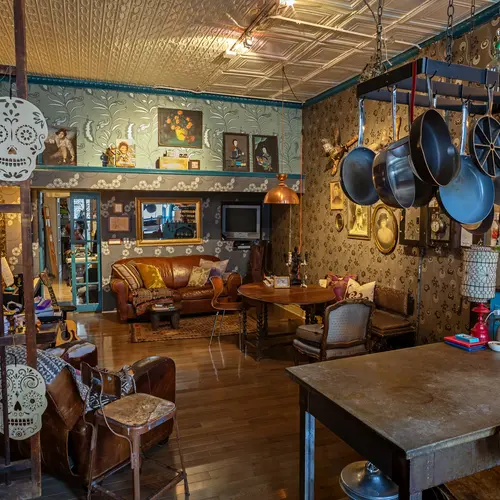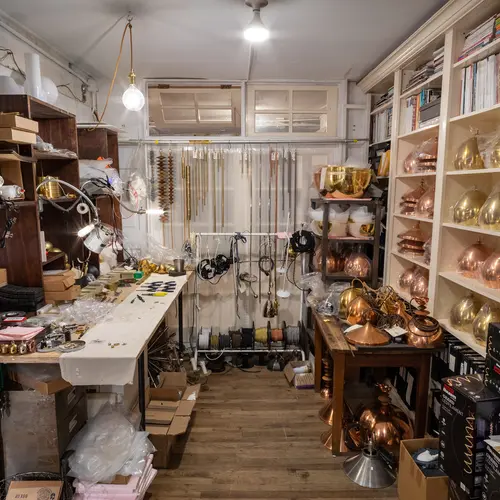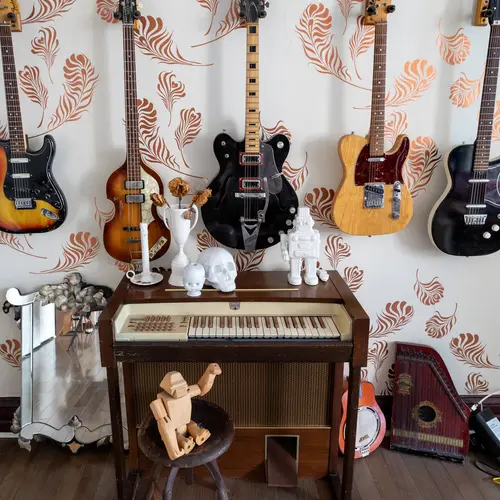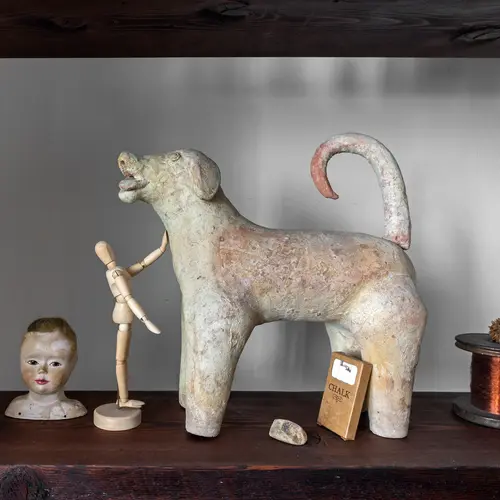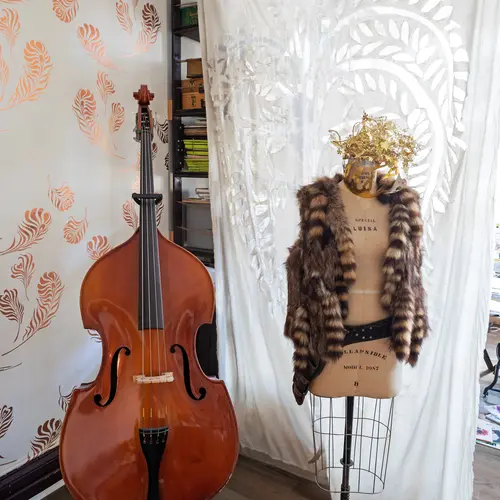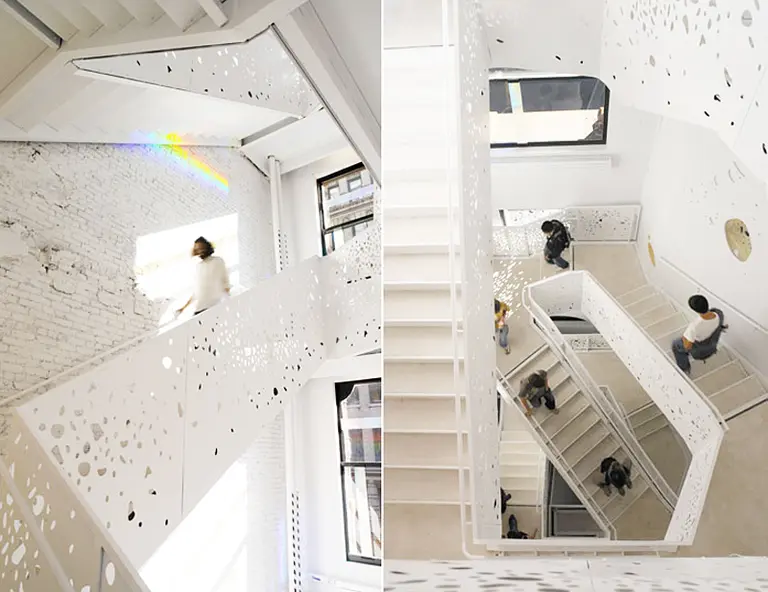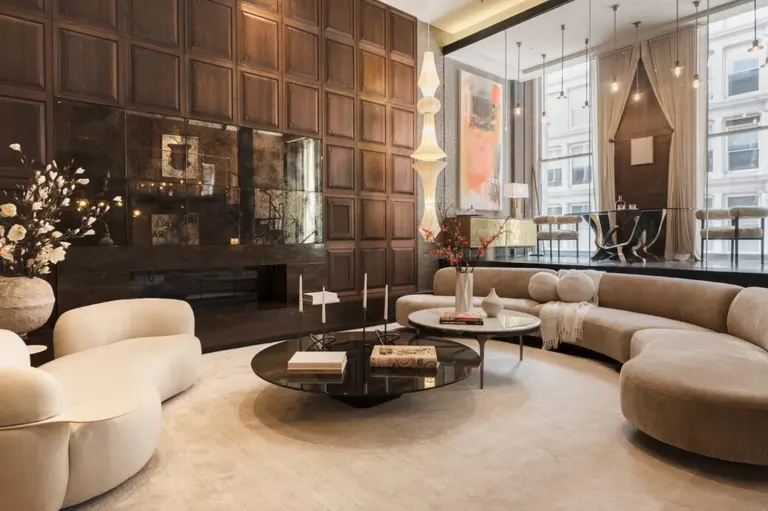My 1,600sqft: In her eponymous shop and Soho loft, designer Michele Varian celebrates creativity
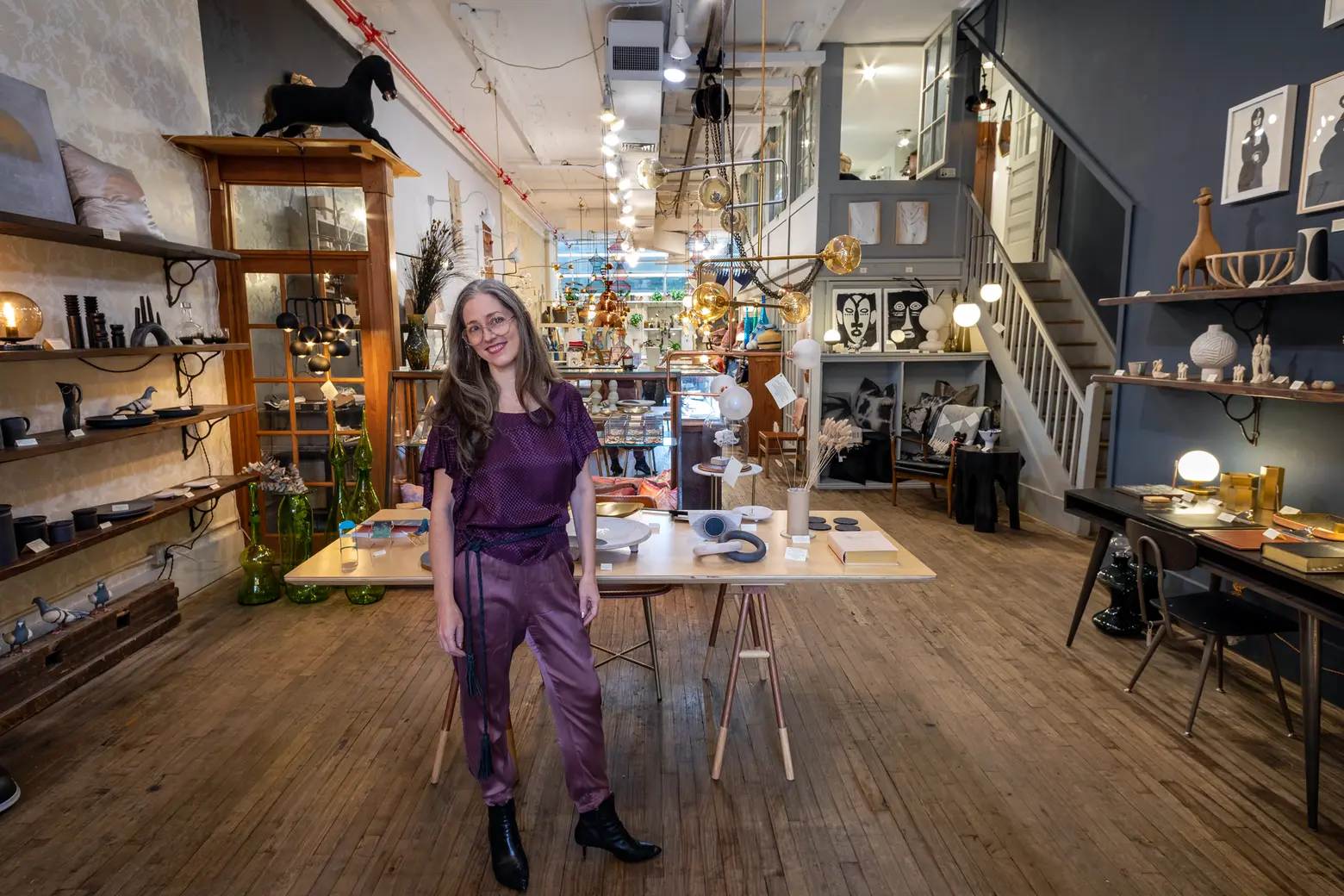
Our series “My sqft” checks out the homes of New Yorkers across all the boroughs. Our latest interior adventure brings us to the Soho loft and eponymous shop of designer Michele Varian. Want to see your home featured here? Get in touch!
For the design-minded, Michele Varian’s Soho storefront is a must-visit destination, stocked to the brim with her own designs alongside a rotating cast of 100+ designers. Since opening her first store in 2001, Michele has sought to create an oasis for quality pieces that straddle the line between tradition and modernity. Like a cabinet of curiosities, the shop offers an antidote to the increasing homogeneity of the retail experience in Soho.
Just a couple blocks away on Broadway, Michele lives in a quintessential Soho loft with her rock star husband, Brad Roberts of the Crash Test Dummies. Michele’s signature aesthetic and eye for the handmade is apparent in the duo’s eclectic and inviting space, which is a testament to their lives together. Filled with bold pattern plays, curiosities from their travels, and Brad’s collection of musical instruments, there’s hardly a surface that doesn’t catch the eye or capture the imagination. Ahead, tour Michele’s shop and loft and find out how she balances (and often intertwines) work with life.
Michele’s ability to weather the times and remain a mainstay in the neighborhood is largely due to her community-driven focus—in addition to being a shop owner and designer, Michele is also a passionate tenant’s rights advocate and small business supporter. That aspect of her work “definitely comes from my parents (tons of social grit), being from the Midwest (friendly) and from Detroit (scrappy),” Michele told us. “Be the change you want to see sounds so corny, but well, you can’t complain about things not being the way that you like, if you’re not willing to do something about it!”
Her initiatives include the Design Talk Roundtable event series that regularly takes place in the store; Detroit Built & Co., a retail platform supporting Detroit-based makers created in partnership with fellow Detroit-native Jay Norris; and Guesst.co, an online platform that connects small-scale makers with brick and mortar stores that can stock their products.

The Michele Varian shop stocks Michele’s own textile, wallpaper, lighting, and furniture designs in addition to curated housewares and jewelry by more than 100 other designers.
Tell me a little about the house where you grew up in Detroit. How did it influence your thinking about design?
My parents bought our house when my sisters and I were just a year and a half old (I’m one of triplets). It’s the only “home” I’ve ever known, and I’m lucky that it is still where my parents live. It is truly an anchor. When I think now that they were still in their 20’s when they bought a mansion in Detroit that needed all new electrical and eventually a new roof, boiler and most of its plumbing when they had three small babies, they were pretty bad-ass!
They didn’t have lots of money, and so they figured out how to repair and renovate everything themselves, which meant my sisters and I learned too. I spent many a weekend stripping paint, hanging drywall with my Mom, and doing electrical work with my Dad. This definitely helped to cultivate my DIY attitude. Because much of Detroit was built while the city had a great deal of wealth during the early part of the 20th century, the quality of materials and craft employed in the buildings is amazing. It certainly contributed to my appreciation of how things are made and my problem-solving skills.
You moved to New York City to attend Parsons School of Design in 1986. What were your first thoughts about NYC? What do you miss most about the city as it was then?
Relative to Detroit, which had much like NYC, suffered years of economic decline, NYC seemed to be percolating with opportunity. It has always been a place where ambitious people come to pursue success, and I loved being around so many talented and smart people, many from different parts of the world and very different backgrounds from my own. It makes me sad that the city has become prohibitively expensive, minimizing opportunities for people like myself, who didn’t come to the city with financial resources but had lots of grit and talent. It is making the city homogenous economically, culturally, and socially.

Michele first opened her retail shop in 2001 in SoHo, where she was an early pioneer of the Crosby Street retail corridor. Now the shop is located in its third and largest retail location at 27 Howard Street, just down the street from her earlier spaces and roughly three times the size of the original location.
After many years in the fashion industry, you decided to go off on your own and began by making pillows. Can you tell us about that transition and how it led you to open your first shop in 2001?
When I decided to start my own design company, I wanted to be able to finance it myself, so instead of making clothing, which has extremely expensive development and start-up costs, I switched to home. I had all of my textile resources from fashion, and unlike fashion, where it takes many expensive prototypes to make something that fits, I figured that every pillow cover fits a pillow. It’s just a square! Also, the home market was pretty wide open at that time. Within the first year, I was selling to several dozen shops around the country, plus Neiman Marcus and Barney’s (wiping tears away…)
Then 9/11 happened, and all the trade shows were canceled. No buyers were coming to NYC, and so I decided if no stores were coming to buy my collection, I would just open my own store! And so I did. Just around the corner from my apartment on the edge of Chinatown and Soho.
How did you grow the company to what it is today?
I began sewing everything myself, then hired and trained my first seamstress, still working out of my loft. When I opened the store, I moved my manufacturing to behind the store. When I moved to a larger space, I began manufacturing lighting too, still onsite, but downstairs from the store. I’ve added new product lines as opportunity allowed.
In addition to your own designs, your shop stocks the work of over 100 designers and more than 70 jewelry designers. How do you source the items and what do you look for?
In the very beginning, I began carrying the work of other friends who were making things. Much as I love designing, I love curating the store almost as much. I’ve now had a store for 18 years, the business for over 20. I’ve met so many people. My resources have accumulated over the years, and now I receive product submissions from new designers everyday. Designers know my store and aesthetic and want to be a part of it.


 The shop’s basement level houses a UL-listed lighting design and fabrication studio where most of Michele’s own designs are manufactured.
The shop’s basement level houses a UL-listed lighting design and fabrication studio where most of Michele’s own designs are manufactured.
Over the years you’ve started several initiatives to support makers and small businesses. Why is that important to you?
As NYC and the world changes, it’s important to me to create as many opportunities to foster innovation and as much new product and business development as possible. I don’t want to live in a boring world, in which only heavily funded ideas come to fruition. In order for me to find new, independent designs to buy and introduce via my store, I need for there to be new designs and design companies. That doesn’t happen without nurturing and creating opportunities and sustainability for small businesses.
You’ve had a number of celebrities come into the shop, who was your favorite and what was the encounter like?
Well, David Bowie was absolutely my favorite. The first time I happened to be at the shop when he came in, I was on the store floor by myself. I could barely walk and talk, I was so gob-smacked. He was delightful and clearly trying to put me at my ease. He walked around the store shopping and singing along to the music that was playing. Then he stopped singing, and said, “Oh, this is me!” after asking if the music was streaming. I then told him that I owned all the music that I play at the store. And he walked around some more still singing and then said, “but this just came out!” To which I replied, “Yes, I know. I’m a big fan.”
As soon as he left, I called my husband and said, “Who is the coolest person who could possibly have come shopping in the store today?” And without missing a beat, he said, “I don’t know, David Bowie?” Ha!

Next to a wood-burning stove, Michele created a cozy window seating nook. The pillows are all her own designs. Above, a collection of (mostly) landscape paintings was acquired by Brad from thrift shops when he still lived in Canada.

The pink cats presiding over the kitchen sill were a gift from Michele’s old landlord. “He owned the storefront downstairs from my loft, which was an air-conditioning repair service,” she told us. “He used to stand outside and yell, ‘Tikki Takka, Tikki Takka,’ to any woman he thought was attractive. He died, so I think I can say that I punched him once, when he got too fresh.” The cactus next to them is one of the very few houseplants in the apartment. “It’s one of two plants that I’ve barely kept alive—the other is a barely recognizable hydrangea.”

Michele and Brad custom built all of the kitchen counters to make use of every possible nook. They also installed open built-in shelves here and throughout the apartment to display the many objects they’ve acquired over the years.
How do you describe your apartment’s aesthetic? Was it hard or fairly organic to meld your style with Brad’s?
No, that was easy. We’re both equally charmed by elements from each other’s lives, worlds, travels, etc…Once, an old boyfriend (before I met Brad) said, being in your apartment is like being surrounded by you. Now, being in our apartment is like being surrounded by both of us. There are his instruments EVERYWHERE, plus the designs and art by me and friends, and many things that we’ve purchased together, often from flea markets and vintage shops.

A wooden barn door and hanging pot rack create a sense of separation between the kitchen and den area.
 The wallpaper in the dining nook is by Neisha Crosland, whose designs Michele stocked in her store before she started making her own.
The wallpaper in the dining nook is by Neisha Crosland, whose designs Michele stocked in her store before she started making her own.

Michele often arranges smaller objects and paintings within empty frames.
There’s such a clear contrast between the dark, moody front room and the light-filled big room. How do you use the two spaces throughout the day?
Since Brad and I are often working from home at the same time, having the two different and distinctive spaces is great for us. He prefers the moodier, darker, quieter room. I like the bigger brighter room, which overlooks Broadway and is flooded with light and the constant hum from the street.
What’s your favorite spot in the apartment and why?
We have huge sun-filled windows at both ends of the apartment, and I have created “seating” in both of them. The back windows are part of the kitchen, and so I built a corner window bench in front of one of the windows, which is filled with cushions. It’s a great place to sit and chat while someone is working in the kitchen.
Just inside the front windows, I’ve hung a colorful swing chair, which is from my shop. Unlike the back of our apartment, which is always pretty quiet, this end looks over Broadway. Having the swing there is like sitting on an urban front porch. We’re on the 4th floor, so we’re pretty far above the hustle and bustle of Broadway, but I find it stimulating to watch and be aware of.

A narrow hallway leads from the kitchen to the bright, Broadway-facing “big room,” as Michele calls it. Featuring a patchwork of tin ceiling panels overhead, it doubles as a living area and workspace. During dinner parties, guests eventually make their way here, where layers of rugs and seating options create a cozy environment.

Michele’s own “Thornbird” wallpaper covers the closet doors and her “Plume” design is the backdrop for Brad’s guitar wall.

Beneath Brad’s guitar collection is an Optigan from the 1970s that appeared—along with other toy instruments—on the Crash Test Dummies album “Ooh la la.”
 Subtly concealed by a panel of hand-painted fabric, Michele’s home workspace is where all the magic begins.
Subtly concealed by a panel of hand-painted fabric, Michele’s home workspace is where all the magic begins.
Tell me about your workspace. Do you do administrative work in the same space as more creative work? How do you balance those worlds?
I have two desks next to each other. One is intended for administrative and computer work, the other is intended for painting, and other creative stuff. No matter the intention, the lines get blurred daily! They’re both usually a mess, but if you ask me to find something, I can. It’s organized chaos. I wear lots of different hats every day.
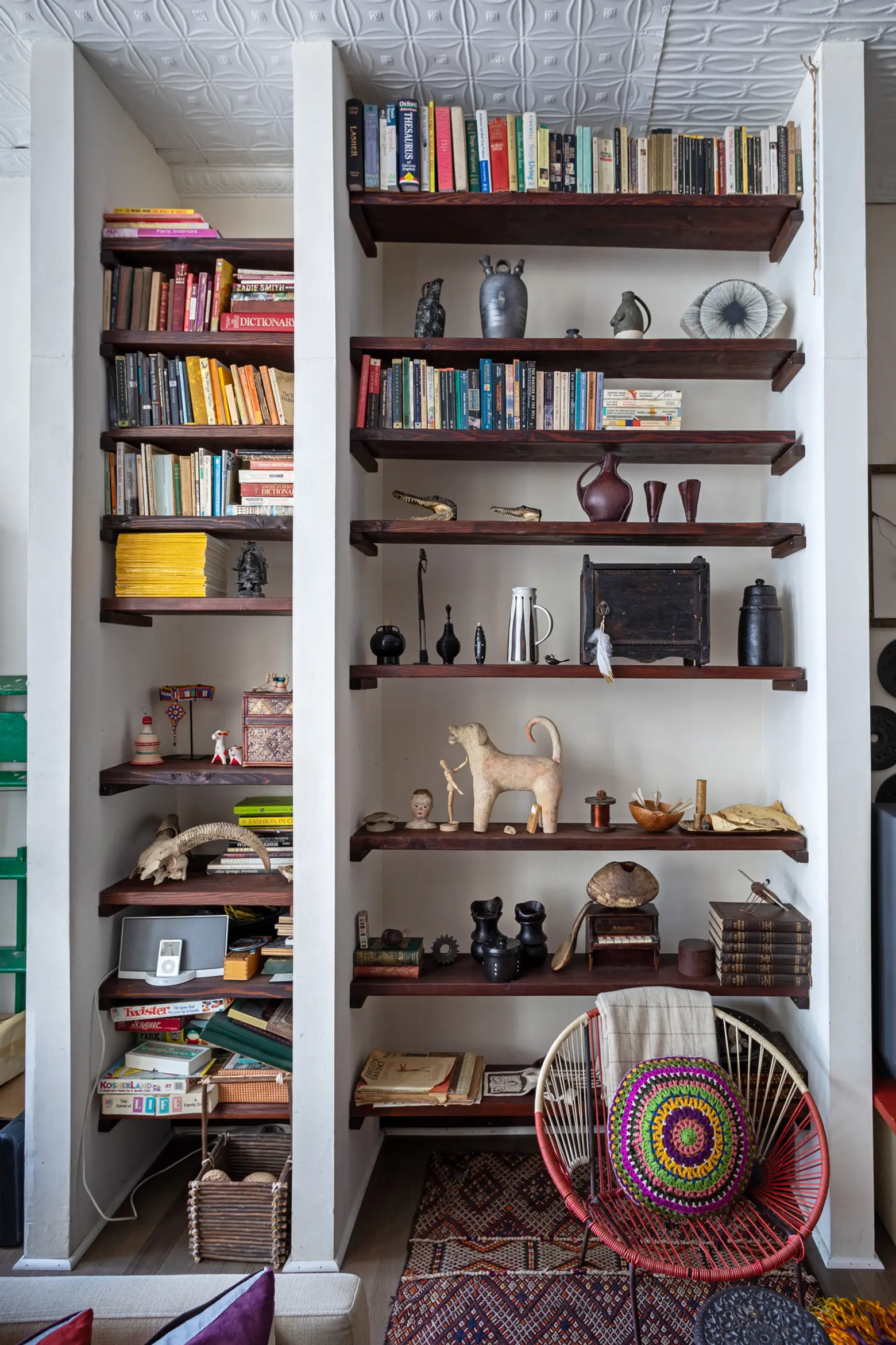 Built-in shelves display objects collected over the years, ranging from cheap market finds to collectible pieces. Some pieces from the store earn a coveted spot on the shelves, like the ceramic eye made by artist Michele Quan.
Built-in shelves display objects collected over the years, ranging from cheap market finds to collectible pieces. Some pieces from the store earn a coveted spot on the shelves, like the ceramic eye made by artist Michele Quan.

If you could only keep three pieces from your apartment, which would you choose?
Only three?!? Ok. A primitive ceramic dog that a friend carried home on her lap from somewhere in the Middle East, the vintage folding chair that I use at my desk, and Brad.
What are your favorite spots in the neighborhood?
Ed’s Lobster Bar, my neighborhood deli, the quiet of the streets in the early morning.
Do you have any advice for someone who might be interested in opening up a shop of their own?
The day you buy something that you don’t love, shut it down.
RELATED:
- My 750sqft: A marketing strategist’s passion for sustainability is on full display in her Park Slope pad
- My 400sqft: How a lifestyle blogger and her husband make small-space living work for them
- My 2,400sqft: Inside Compass agent Christine Blackburn’s custom-designed Fort Greene home
All photos by James and Karla Murray exclusively for 6sqft. Photos are not to be reproduced without written permission from 6sqft.

